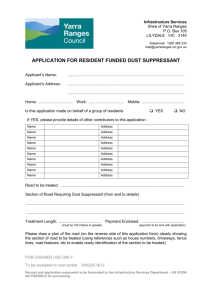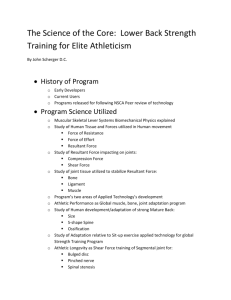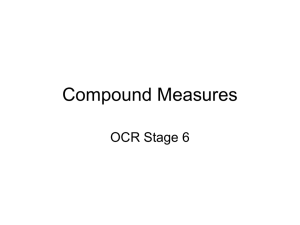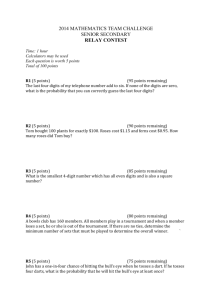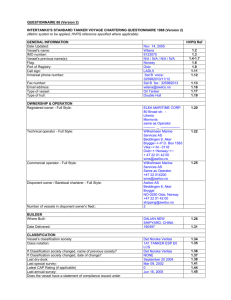National Diploma in Engineering Mechanical Principles for
advertisement
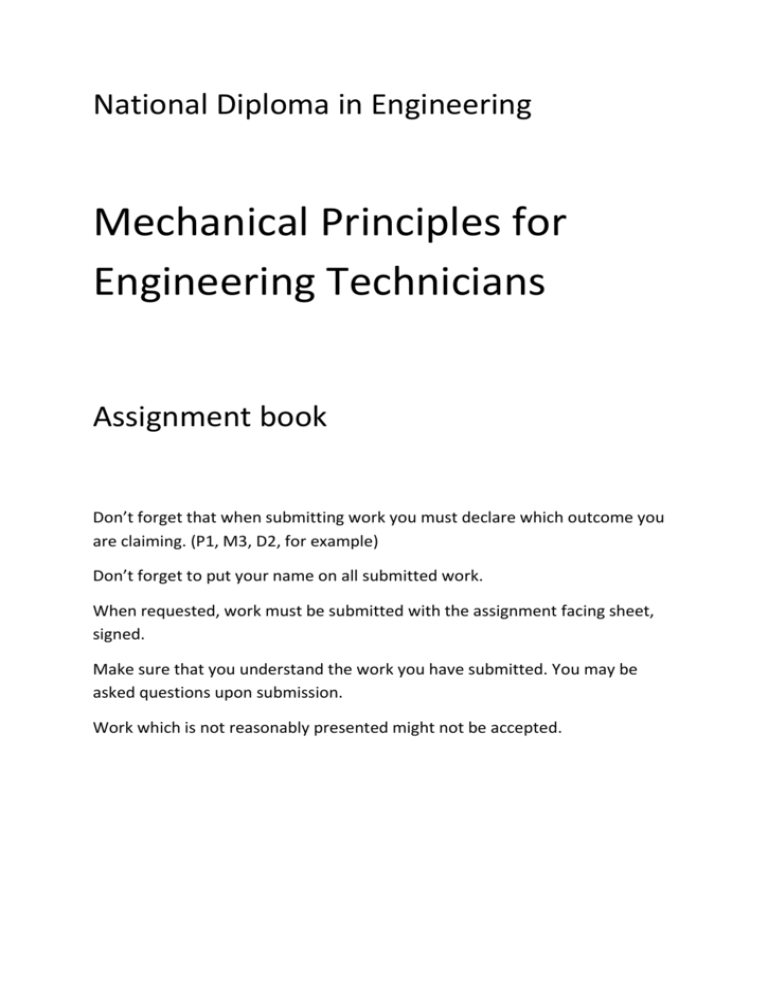
National Diploma in Engineering Mechanical Principles for Engineering Technicians Assignment book Don’t forget that when submitting work you must declare which outcome you are claiming. (P1, M3, D2, for example) Don’t forget to put your name on all submitted work. When requested, work must be submitted with the assignment facing sheet, signed. Make sure that you understand the work you have submitted. You may be asked questions upon submission. Work which is not reasonably presented might not be accepted. P1 calculate the magnitude, direction and position of the line of action of the resultant and equilibrant of a non-concurrent coplanar force system containing a minimum of four forces acting in different directions. Calculate the magnitude, direction and position of the line of action of the resultant and equilibrant of this system of non-concurrent coplanar forces. The angles are; a = 100° b = 130° c = 90° d = 135° P2 calculate the support reactions of a simply supported beam carrying at least two concentrated loads and a uniformly distributed load Calculate the support reactions of this simply supported beam. P3 calculate the induced direct strain and dimensional change in a component subjected to direct uniaxial loading and the shear stress and strain in a component subjected to shear loading 1) A strut of diameter 30mm and length 2.5m carries a direct uniaxial compressive load of 30kN. The modulus of elasticity is for the material is 160 GPa. Find (a) the compressive stress in the material, (b) the strain and (c) the change in length of the strut. 2) A block of material is subjected to a shear force of 50kN and is deformed as shown below. Find (i) the shear stress and (ii) the shear strain. P4 solve three or more problems that require the application of kinetic and dynamic principles to determine unknown system parameters For P4 for this unit solve the problems in questions 1 to 4. Question 1) A missile has a mass of 2000 tonnes and exerts a thrust of 40 MN. Assuming the missile lifts vertically determine the initial upward acceleration of the missile. If this thrust is maintained, and assuming a negligible loss of mass within the first few seconds, what height will be achieved 6 seconds from lift-off? What velocity will be achieved at this point? Question 2) A block of mass 60kg is pulled up an incline the angle of which is 35° from the horizontal. (See figure 1). There is an opposing friction force of 50 N. If the linear distance from A to B is 12 metres calculate: a) The force required to move the block at a constant velocity, b) The work done moving the block from A to B, and c) The average power required to do this work in a time of 20 seconds. Question 3) A mass of 20kg is lifted to a height of 15 metres above the ground. Calculate the potential energy gained. If the mass is allowed to fall freely under gravity what is its velocity when it returns to the ground? Question 4) A wagon of mass16 tonnes moving along a track at 10 km/h, collides with a second wagon, of mass 8 tonnes moving at 7 km/h; both wagons are moving in the same direction. Immediately after the collision, the 8 tonne wagon moves along at 10 km/h. Calculate the velocity of the 16 tonne wagon after impact. P5 calculate the resultant thrust and overturning moment on a vertical rectangular retaining surface with one edge in the free surface of a liquid Part of a sea defence consists of a section of concrete wall 4 metres high and 6 metres wide. (See figure below). Calculate the resultant thrust on the section when the sea reaches a height of 3 metres relative to the base of the section. Calculate the overturning moment experienced by the section. P6 (See also D2) determine the up-thrust on an immersed body A steel bar of length 0.6m and diameter 70mm is suspended from a chain and lowered into a tank of liquid whose relative density is 0.9. Determine the tension in the chain when the bar is fully immersed. The density of the water is 1000kg/m³ and the density of steel is 7870kg/m³. P7 use the continuity of volume and mass flow for an incompressible fluid to determine the design characteristics of a gradually tapering pipe For this pipe the diameters are:(1) 120mm (2) 70mm (3) 160mm The pipe contains oil with a density of 880kgmˉ³. Its velocity is 10msˉ¹ at point (2). Calculate the volume flow rate, the mass flow rate, and the flow velocities at points (1) and (3). P8 calculate dimensional change when a solid material undergoes a change in temperature and the heat transfer that accompanies a change of temperature and phase (i) A brass bar has a length of 1.5 metres at 20°C. What is the increase in length of the bar at 100°C if the coefficient of linear expansion of brass is 19.5x10¯6 /° C? (ii) Calculate the heat energy required to change10kg of ice at −5°C to water at 0°C. the specific heat capacity of ice is 2.1 kJkgˉ¹Kˉ¹ and the specific latent heat of fusion is 335 kJkgˉ¹ . P9 solve two or more problems that require application of thermodynamic process equations for a perfect gas to determine unknown (i) A mass of 0.1 kg of air has an initial temperature of 600°C and pressure 1 MPa. If the air is expanded according to the law pV1.2 to a final volume of 100 litres determine (a) its initial volume, (b) its final pressure, (c) its final temperature. For air, take R = 287 Jkgˉ¹ Kˉ¹. (ii) Air with an initial volume of 0.1m³, pressure 1 bar and temperature 15°C is compressed according to the law pV1.3 = c through a 9:1 compression ratio. It is then allowed to expand isothermally back to its initial volume. Determine (a) the pressure and temperature after compression and (b) the final pressure. M1 calculate the factor of safety in operation for a component subjected to combined direct and shear loading against given failure criteria The material for the bolt shown in the angled joint shown has an ultimate tensile strength of 460 MPa and a shear strength of 280 MPa. The diameter of the bolt is 8mm. Determine both the tensile stress and shear stress in the bolt, and determine the factor of safety in operation. The angle at a is 50°. M2 determine the retarding force on a freely falling body when it impacts upon a stationary object and is brought to rest without rebound, in a given distance A pile-driver has a hammer mass of 1000 kg which is dropped onto a pile from a height of 5 metres. The pile is driven 0.5 metres into the ground. The pile has a mass of 500 kg. Calculate the retarding force exerted by the ground on the combined mass of the pile and hammer. M3 determine the thermal efficiency of a heat transfer process from given values of flow rate, temperature change and input power A coal fired steam plant takes in feed water at a temperature of 70°C and produces 15 tonnes of steam per hour at a pressure of 60 bar and temperature 400°C. The fuel consumption rate is 1.5 tonnes per hour and the calorific value of the fuel is 40MJkgˉ¹. Determine the power rating of the boiler and its thermal efficiency. M4 determine the force induced in a rigidly held component that undergoes a change in temperature. Q2. A steel tie bar of length 1m and diameter of 30mm is tensioned to carry a load of 180kN at a temperature of 20°C. What is the stress in the bar and its change in length when tensioned? What will be the stress in the bar if the temperature rises to 80°C and any change in length is prevented? Take E = 200GPa and α = 12 x 10 ˉ⁶ °Cˉ¹. D1 compare and contrast the use of D’Alembert’s principle with the principle of conservation of energy to solve an engineering problem To gain a distinction for this assignment you need to solve the problem using two alternative approaches, one being D`Alembert`s principle, and the other being the principle of the conservation of energy. The principle of conservation of energy equates work done in a system to changes in potential energy, changes in kinetic energy, and other energy losses. D`Alembert`s principle equates work done to the sum of all forces applied in a system. These are two alternative, and sometimes complimentary, approaches. You are asked to compare and contrast the two methods in relation to the problem you are solving. . A block with a mass of 5kg is pulled up an incline with an angle of 20°. (See figure 2). The coefficient of friction is 0.2. The distance from A to B is 10 metres. The block accelerates uniformly from 1msˉ¹ at point A to 5msˉ¹ at point B. Calculate: a) The pulling force which is producing the acceleration b) The work done in moving the block from A to B c) The average power required in moving the block from A to B D2 (See also P6) evaluate the methods that might be used to determine the density of a solid material and the density of a liquid Evaluate the methods that might be used to determine the density of a solid material and the density of a liquid.
